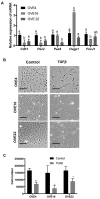PAX2 maintains the differentiation of mouse oviductal epithelium and inhibits the transition to a stem cell-like state
- PMID: 29100356
- PMCID: PMC5652750
- DOI: 10.18632/oncotarget.20173
PAX2 maintains the differentiation of mouse oviductal epithelium and inhibits the transition to a stem cell-like state
Abstract
Recent studies have provided evidence that the secretory cells of the fallopian tube (oviduct) are a probable origin for high-grade serous ovarian carcinoma. In addition to secretory cells, the fallopian tube epithelium consists of ciliated cells and CD44+ undifferentiated stem-like cells. Loss of PAX2 expression is recognized as an early event in epithelial transformation, but the specific role of PAX2 in this transition is unknown. The aim of this study was to define the role of PAX2 in oviductal epithelial (OVE) cells and its response to transforming growth factor β1 (TGFβ), characterizing specifically its potential involvement in regulating stem cell-like behaviors that may contribute to formation of cancer-initiating cells. Treatment of primary cultures of mouse OVE cells with TGFβ induced an epithelial-mesenchymal transition (EMT) associated with decreased expression of PAX2 and an increase in the fraction of cells expressing CD44. PAX2 knockdown in OVE cells and overexpression in ovarian epithelial cells confirmed that PAX2 inhibits stem cell characteristics and regulates the degree of epithelial differentiation of OVE cells. These results suggest that loss of PAX2, as occurs in serous tubal intraepithelial carcinomas, may shift secretory cells to a more mesenchymal phenotype associated with stem-like features.
Keywords: PAX2; epithelial-mesenchymal transition; fallopian tube; ovarian cancer; stem cells.
Conflict of interest statement
CONFLICTS OF INTEREST The authors declare no conflicts of interest.
Figures








Similar articles
-
UnPAXing the Divergent Roles of PAX2 and PAX8 in High-Grade Serous Ovarian Cancer.Cancers (Basel). 2018 Aug 8;10(8):262. doi: 10.3390/cancers10080262. Cancers (Basel). 2018. PMID: 30096791 Free PMC article. Review.
-
The PAX2-null immunophenotype defines multiple lineages with common expression signatures in benign and neoplastic oviductal epithelium.J Pathol. 2014 Dec;234(4):478-87. doi: 10.1002/path.4417. Epub 2014 Sep 30. J Pathol. 2014. PMID: 25130537 Free PMC article.
-
[Origin of ovarian epithelial inclusions and its relationship with the development of low-grade serous carcinoma].Zhonghua Fu Chan Ke Za Zhi. 2011 Oct;46(10):729-35. Zhonghua Fu Chan Ke Za Zhi. 2011. PMID: 22321344 Chinese.
-
PAX2-null secretory cell outgrowths in the oviduct and their relationship to pelvic serous cancer.Mod Pathol. 2012 Mar;25(3):449-55. doi: 10.1038/modpathol.2011.175. Epub 2011 Nov 11. Mod Pathol. 2012. PMID: 22080059
-
The fallopian tube as the origin of high grade serous ovarian cancer: review of a paradigm shift.J Obstet Gynaecol Can. 2014 Feb;36(2):133-140. doi: 10.1016/S1701-2163(15)30659-9. J Obstet Gynaecol Can. 2014. PMID: 24518912 Review.
Cited by
-
UnPAXing the Divergent Roles of PAX2 and PAX8 in High-Grade Serous Ovarian Cancer.Cancers (Basel). 2018 Aug 8;10(8):262. doi: 10.3390/cancers10080262. Cancers (Basel). 2018. PMID: 30096791 Free PMC article. Review.
-
SMAD proteins directly suppress PAX2 transcription downstream of transforming growth factor-beta 1 (TGF-β1) signalling in renal cell carcinoma.Oncotarget. 2018 Jun 1;9(42):26852-26867. doi: 10.18632/oncotarget.25516. eCollection 2018 Jun 1. Oncotarget. 2018. PMID: 29928489 Free PMC article.
-
The Tumor Immune Profile of Murine Ovarian Cancer Models: An Essential Tool For Ovarian Cancer Immunotherapy Research.Cancer Res Commun. 2022 Jun;2(6):417-433. doi: 10.1158/2767-9764.crc-22-0017. Epub 2022 Jun 9. Cancer Res Commun. 2022. PMID: 36311166 Free PMC article.
-
Loss of tubal ciliated cells as a risk for "ovarian" or pelvic serous carcinoma.Am J Cancer Res. 2020 Nov 1;10(11):3815-3827. eCollection 2020. Am J Cancer Res. 2020. PMID: 33294269 Free PMC article.
-
Mutant p53 murine oviductal epithelial cells induce progression of high-grade serous carcinoma and are most sensitive to simvastatin therapy in vitro and in vivo.J Ovarian Res. 2023 Nov 20;16(1):218. doi: 10.1186/s13048-023-01307-x. J Ovarian Res. 2023. PMID: 37986175 Free PMC article.
References
-
- Auersperg N, Wong AS, Choi KC, Kang SK, Leung PC. Ovarian surface epithelium: biology, endocrinology, and pathology. Endocr Rev. 2001;22:255–288. - PubMed
-
- Yao DS, Li L, Garson K, Vanderhyden BC. The mouse ovarian surface epithelium cells (MOSE) transformation induced by c-myc/K-ras. Zhonghua Zhong Liu Za Zhi. 2006;28:881–885. - PubMed
-
- Hodgkinson KM, Vanderhyden BC. Consideration of GREB1 as a potential therapeutic target for hormone-responsive or endocrine-resistant cancers. Expert Opin Ther Targets. 2014;18:1065–1076. - PubMed
LinkOut - more resources
Full Text Sources
Other Literature Sources
Research Materials
Miscellaneous

